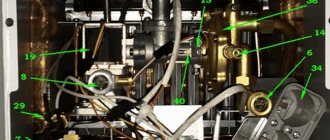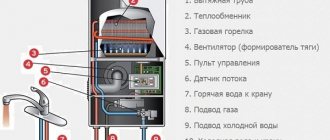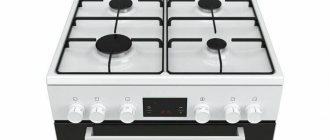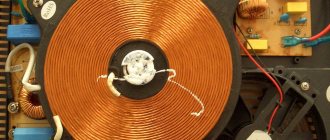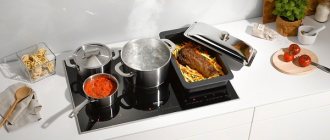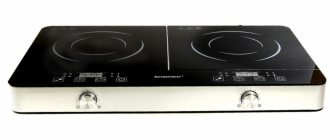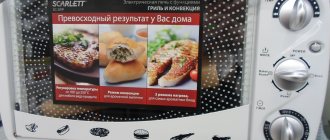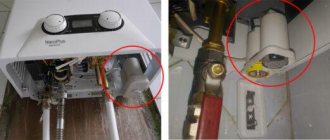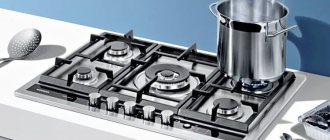These household appliances have gained great popularity - the tariffs are fair, and if you install a gas meter, the bills will be minimal. Massive gasification was carried out everywhere back in the days of the USSR, which is why most Russians have just such products installed. Despite its widespread use, users are still often interested in the design of a gas stove. Let's consider its main functional units and the principle of their interaction.
Slab design
A modern gas stove combines several systems, each of which is responsible for the normal functioning of controlled parts and devices.
- The basic one is a gas system. It consists of burners, burners, pipelines and shut-off valves.
- Electric - it is responsible for lighting, electric ignition, and in some models ensures the operation of the grill installation.
- The supporting structure is the body of the product, which is made of stainless steel sheet and coated with enamel.
Each gas stove has a standard set of parts. Different models may have their own nuances and unique design, but the composition of the main components has not changed. The schematic diagram of a gas stove is shown in the photo below.
General principle of operation of the equipment
Regardless of the type of model, its cost and arrangement of elements, all equipment works according to the same scheme. The only exception may be some exotic industrial equipment with combined fuel.
Operating principle of a gas stove:
- Gas is supplied to the burner from the mains or an independent source (cylinder).
- After opening the shut-off valve, fuel flows to the burner.
- The design includes a mixing system, where gas, in contact with air, changes its properties.
- The mixture is taken to the divider, where it is evenly distributed around the perimeter.
- Using auto-ignition or a match, the composition is ignited, and combustion is maintained at a user-specified level.
If the system is debugged and works as the manufacturer intended, then the fuel will burn completely without emitting fumes, and the flame will stably maintain the selected level. The efficiency will remain close to 100%. A faulty system will smoke, periodically go out, or refuse to ignite at all.
Burner products
Many people confuse the burner and the burner, so the burner is located inside the stove under the hob, and on top there are burners with dividers, which can be removed and wiped during wet cleaning (just try not to let water get into the holes of the divider). If you remove the burner, then underneath it in the depths you can see the burner body and the nozzle, from the hole of which the gas enters the socket of the divider, where it mixes with air for stable combustion. Each burner is characterized by a certain power; in everyday life there are the following options:
- minimum flame when the regulator is in the extreme left position;
- medium heat - the regulator is in the middle;
- maximum combustion - the regulator is in the extreme right position, the burner is completely heated, the flame is stable and does not come off the divider, the gas burns completely.
Gas burner diagram
Experts have this concept - the optimal power of a product. It is determined by the most complete combustion of blue fuel and is indicated in the technical characteristics of the gas stove.
When switching to another type of fuel, for example, liquefied gas from cylinders, it is necessary to change the jets, and the entire set. It is better to entrust such work to a professional - he will immediately adjust the pressure and ensure that complete combustion of the fuel occurs.
There are only three types of burners commonly used:
- diffusion;
- kinetic;
- mixed option.
The names come from the combustion feature: in the first version, there is no forced mixing with air - a stream of gas enters the bell of the burner, where it naturally mixes with air. The oven burner is of the first type - air is taken from the inside of the stove. In the second option, suction is carried out due to the energy of gas movement under low pressure, mixing occurs and the combustible mixture is supplied to the burner. In modern models, a third option is used, when half of the air is taken from inside the product, and then in the bell of the burner the mixture is additionally mixed with the outside air of the kitchen.
Gas stove device
A modern device combines several systems that work in conjunction with each other. The slab combines the following systems:
- basic, which includes parts directly related to the supply and combustion of gas: pipeline, shut-off valves, burners and burners;
- the electrical part, which allows you to use the device more comfortably, includes electric ignition, lighting, and, in some models, power supply to the grill;
- frame, usually made of stainless steel and coated with heat-resistant and impact-resistant enamel.
Gas burner device
A burner and a hotplate are two different things, although many people often confuse them out of ignorance. The burner is located in the stove, under the hob, while the burners are located in the upper part. When washing, they are removed and wiped, trying to prevent moisture from getting inside the dividers. Under the burner there is a burner body with a nozzle. From it, the gas enters the divider, where it is mixed with air. The regulator controls the gas supply from the burner - from the weakest (extreme left position) to the maximum (extreme right position of the regulator).
Depending on whether natural or bottled gas is used, replaceable sets of nozzles are installed on the burners. It is not recommended to change the jets or adjust the pressure yourself; it is better to entrust this matter to a specialist.
Three types of burners are used:
The names come from the principle of operation: in diffusion burners, gas naturally mixes with air after passing through the socket of the divider. This is the option used in the oven. With diffusion-type burners, the gas enters under pressure, due to which air is sucked in, and the ready-made mixture enters the burner. Modern gas stoves are equipped with mixed-type burners, in which part of the air comes from inside the stove, and part of it enters the burner from the kitchen area.
Gascontrol
The combustion process is controlled by a thermocouple that shuts off the gas if one of the burners goes out. For the Gascontrol system to operate, it is not necessary to have a power supply; it operates independently of it.
During operation, the thermocouple heats up; the damper, controlled by an electromagnetic valve, is in the open position. If the flame goes out as a result of water boiling away and splashing onto the burner, the cooled thermocouple stops acting on the valve and the damper closes.
Electric ignition
Often modern stoves are equipped with an electric ignition system. It includes spark plugs powered by electricity and located next to the burners. Power is supplied to them by pressing a button. If there is no voltage in the network, it doesn’t matter. Calmly open the gas supply valve to the burner and use good old matches.
Electrical system
There should be no questions about classic ignition: light a match, bring it to the burner, and the gas ignites. Modern models are equipped with more advanced systems with a piezo element. The latter is a small module with an outlet to the burner, where when you press a button, a spark appears that ignites the fuel.
The equipment can be equipped with both fully automatic and semi-automatic ignition systems . The latter is installed, as a rule, on budget and mid-budget gas stoves.
- Automatic ignition. Immediately after turning the lever to supply gas, the piezo element on the selected burner is activated and ignition occurs.
- Semi-automatic ignition. When you press the button, a spark passes through all the burners, but only the one where the gas valve was opened lights up.
Both systems depend on electricity and will not work without it. In this case, you will have to use matches or a lighter to ignite.
In addition to electric ignition, a gas furnace also has other elements that run on electricity. Very often, developers install an electric grill inside the oven to provide a golden brown crust to the dish. Also, every modern model has an internal lighting system. It is turned on by pressing a special key on the control panel located on the front side of the product. A working oven is illuminated from the inside for visual control of the quality of cooking.
Gas control system
Control over combustion stability is carried out using a thermocouple - it shuts off the gas supply if for some reason the flame goes out. This system is called “gas control”. This control works regardless of the presence of electricity - it all depends on the temperature: when there is no electricity, the thermocouple turns off the gas.
When the gas burner is operating, the thermocouple heats up, the solenoid valve releases the damper, holding it in the open position. When the flame goes out due to unforeseen circumstances, for example: water boiled in the kettle and splashed onto the burner. The quickly cooling thermocouple has no effect on the valve solenoid, the flap closes and the gas supply stops.
Gas stove ignition device
It is clear that the principle of operation of a gas stove is not difficult. The blue fuel is burning, the pots are heating up. Difficulties are hidden by the control and protection device. How does a gas stove work?
To ignite the stove, an electrical circuit using power elements is used. First, how do you find a candle on the stove? The key feature is good electrical insulation. White ceramics prevent the rod from penetrating anywhere past the body of the divider. It is appropriate to remind: the electric stove is grounded for proper operation and the safety of people. The current penetrates the body of the device to produce a spark. The second sign is decisive: if you remove the table, you can see that the wires are coming from the electronic ignition board. Thick, powerful. A twisted pair goes from the thermocouple to the valves, most often located in the area of the power regulators.
Otherwise the candles are similar to each other. As for the operation, you can press the ignition button and visually see where the spark flashes from the candle. The gas must be shut off; it is better to remove the divider cover. There is no control over the supply of blue fuel, therefore, the ignition should work. Combustion control is important...
Gas enters the stove through a pipe and goes to the collector. A pipe equipped with branches, each with a valve. The construction of a gas stove is not complete without protection. A twisted pair goes from the thermocouple to the valve.
If the parts are mixed up during assembly, the gas stove will no longer support combustion and the flame will go out. Even if you manage to light two burners that have been swapped, there is no protection against the fire going out. The situation will happen - you will get a guaranteed explosion. Be careful when connecting thermocouples and solenoid valves.
Gas stove oven
The oven of a gas stove is also equipped with burners, only their size is much larger. Depending on the number and location of heating elements, there are several types of ovens.
- With a bottom burner, without a fan. A budget option. The heating intensity depends on the gas supply and the location of the baking tray with the dish.
- An oven with a bottom burner and a fan is a more advanced option. The fan ensures uniform heating throughout the entire volume.
- The most modern ovens are equipped with several burners: they can be not only at the bottom, but also on the side or even at the top.
To ensure tightness, the oven has a thermal insulation layer. The door is equipped with laminated glass, which allows you to retain heat inside without getting too hot outside.
Hole for igniting the flame in the oven
The heating mode is selected using the control knob. Ignition can be manual or automatic. For the first option, there is a hole at the very bottom in the middle to which a match or a special lighter is placed. There is a red button on the control panel - you must press it to open the gas supply. When the burner lights up, you need to hold the button for a few seconds to heat up the thermocouple that controls the solenoid valve. If you immediately remove your finger from the button, the flame will go out; all actions must be started all over again.
Modern models are equipped with electric ignition, the effect of which is similar to the previously described options for switching on
Household gas stoves
The majority of household gas-using equipment in Russia is made up of household gas stoves; there are more than 40 million of them in operation. They are intended for cooking. The use of gas stoves for other purposes, in particular for space heating, is not permitted. The basic requirements for gas stoves are established by GOST R 50696-2006 “Household gas appliances for cooking. General technical requirements and test methods".
Plates can work:
- on natural gas with a nominal pressure of 130 daPa or 200 daPa;
- on liquefied petroleum gas with a nominal pressure of 300 daPa.
To convert the stove from burning natural gas to burning LPG, it is necessary to replace the burner nozzles. Similarly, to convert a stove designed to operate on 130 daPa natural gas to 200 daPa gas, it is necessary to install nozzles with smaller diameter holes. Manufacturers of plates apply markings indicating the size of the hole on the nozzle by branding.
In a similar way (by replacing nozzles), other gas-using equipment is converted from burning one type of gas to another. If there is a gas valve that regulates the gas pressure in front of the burner, it is also necessary to adjust it to the appropriate pressure. For some water heaters (for example, instantaneous water heater NEVALUX 6011), when converting from natural gas to LPG, the electronic control unit is reconfigured.
The stove is made in the form of a cabinet in which an oven and an auxiliary cabinet are mounted, in which only non-combustible items can be stored. The body parts of the plate are coated with enamel - a thin glassy coating obtained by high-temperature processing. In fact, enamel is colored opaque glass, fused in a thin layer onto a metal base. The enamel is fired at a temperature of 750-900 °C, which allows it to withstand the high temperatures that arise during operation of the stove. Many manufacturers enamel the table grid and baking trays. Enamel protects the metal from corrosion, but is a fragile coating. Mechanical stress causes chipping of the enamel coating, the quality of which cannot be restored with paints and varnishes, even when using heat-resistant enamel paint.
At the top of the stove there is a table with cooking burners. The table grid must be removable and fixed when installed on the table. Table burners can have different designs, but according to the principle of operation they are all low-pressure injection burners. The number of burners can be different: one on portable (tourist) stoves, two, three and four on stationary ones. There are stoves with five and six burners. On modern four-burner stoves, the table burners come in three power ratings: low, normal (2 burners) and high. It is possible to install closed table burners when the cookware is placed on a heating surface that covers the burner. The flame does not have direct contact with the cookware; heat transfer occurs through this surface.
Tables can be enameled, made of stainless steel or tempered glass. Stainless steel tables are not afraid of mechanical damage - impacts - that cause chips of the enamel. The dishes are placed on a table grid, which must withstand exposure to open flames. For high-quality combustion of gas, it is necessary that the combustion process is completed completely, so the flame must have a certain size (the length of an individual torch). If the flame is too large, the combustion process will not have time to complete, and there will be incomplete combustion. The grate ensures the optimal position of the bottom of the pan relative to the burner. It can be steel or cast iron, the second is more reliable and durable.
To get to the gas pipeline of the stove - the ramp - you need to remove the table and distribution panel. The ramp is made of steel pipe, most often with a nominal bore of 15 mm or 10 mm. Burner taps are installed on the ramp. The valves of the plate are conical; the plug is pressed against the body by a spring. The faucet rod turns the plug to the open or closed position, it is held in place by a locking screw, and the faucet handle is placed on it. Most valves turn from a closed to an open position by rotating counterclockwise.
Gas stove tap
The valve must be fixed in the closed position; opening must be carried out after removing the valve from the fixed position. Of all gas-using equipment, stove taps operate under the most difficult conditions, since they are located directly above the oven. When the oven is on, the taps can heat up to 145°C. Their lubricant must be refractory and provide operation for 3 years. The taps of the table burners must withstand 40,000 on-off cycles, the oven (grill) burners - 5,000.
Read: Low pressure injection burners
The handles of the faucets of modern stoves must have a designation that allows you to determine one of three positions of the faucet: “closed”, “large flame” or “small flame”. In this case, in the “small flame” mode, stable combustion should be ensured, without flame slippage.
The oven of modern stoves has thermal insulation made of mineral wool, covered with aluminum foil on top. In the oven, there is a main burner at the bottom (the most powerful burner on the stove), and there may be a fry burner (grill) at the top. Simultaneous supply of gas to the main and frying burners is not allowed. When the main burner burns, the combustion products rise upward, which will not allow the frying burner located on top to burn normally due to lack of air. It will either go out or burn with incomplete combustion of the gas. To avoid simultaneous supply of gas to the main and frying burners, the tap for these burners is made common. When the tap is turned counterclockwise, the gas goes to the main burner, and when turned clockwise, it goes to the fryer. The oven has electric lighting, which allows you to control the process of preparing baked goods and other dishes.
The frying burner (grill) is a low pressure injection burner. It allows you to fry meat on a baking sheet, use a spit to cook chicken and other dishes. In order for the heat from the grill burner to flow downwards, heat transfer by radiation is used, mainly in the infrared range. The burner flame heats up a metal panel or mesh until it glows; infrared radiation travels down through the air and fries the food. Simultaneous operation of oven burners and table burners is allowed. In this case, the table burners must operate without interruption or flashover of the flame.
The oven door must be locked in the open and closed positions. The oven door glass is heat-resistant tempered. Many modern stoves use triple glazing, which reduces the temperature on the glass surface and avoids burns when touched.
There is a group of household stoves in which the table burners are gas, and thermoelectric heaters - heating elements - are installed in the oven. One heating element is installed at the bottom, the other at the top. An electric oven provides better baking quality compared to a gas oven, since two heating elements can operate simultaneously. This allows heat to be applied more evenly to the baked dish. The gas burner of the oven supplies most of the heat to the baked product from below, so baked goods often burn. To solve this problem, convection is used. The convection oven has a fan located in the rear wall. It ensures the circulation of heated air throughout the oven. In this case, the dishes are baked evenly, which is important for a gas oven that has only a bottom burner. In addition, convection allows you to cook on two baking sheets at the same time.
Trays and racks should move freely along the oven guides and not fall out when cold or hot. Many ovens are equipped with telescopic guides. They securely hold the pan on one of several levels. When pulling out the baking tray, you do not need to hold it in your hands to check the quality of the food. This provides greater comfort and safety when using ovens.
Modern stoves are equipped with devices that increase the convenience and safety of their use. These are electric ignition of burners, automatic “gas control”, electric spit drive, oven thermostat.
Stove burner electric ignition circuit
Electric ignition of the burner occurs when a spark jumps between the burner nozzle and the spark gap installed nearby. In order for a spark to pierce the air between the spark gap and the burner nozzle, the stove has a voltage multiplier (VM), which increases the voltage to several thousand volts. It is possible to use a piezoelectric element to ignite burners. Piezoelectricity is obtained from crystals that, when subjected to mechanical action, are capable of generating an electrical discharge. When you press the ignition button, the crystal contracts, a voltage difference appears on the surface, which is converted into a spark gap.
Electric ignition can be single-spark, when a spark jumps after each press of the button, and multi-spark, when sparks jump at certain intervals as long as the ignition button is pressed. Modern stoves use multi-spark ignition, which is less likely to fail. The ignition device can be powered by electric batteries or 220 V AC mains. A number of stoves use rotary controls that combine the functions of a tap and electric ignition. Ignition is performed by turning the regulator and pressing it.
The high-quality operation of the electric ignition of the main oven burner is especially important. Firstly, the oven burner is the most powerful, so a large amount of gas comes out through its nozzle. Secondly, a metal sheet is installed above the burner, as a result a closed volume is created, which creates one of the conditions for an explosion. If ignition does not occur within a few seconds, an explosion may occur. Do not electrically ignite the burners with the oven door closed.
Read: Pipe fittings
The flame control device (automatic “gas control”) must stop the gas supply to the burner when it goes out. As the experience of the emergency dispatch service shows, quite often the cause of gas pollution in the kitchen is gas escaping through the stove burners that are not burning. This can happen when ignition is incorrect, when the gas is turned on to one burner and they try to ignite another, when boiling water splashes out of a pan, when a small flame is blown out by a draft, etc. “Gas control” allows you to avoid unburned gas from entering the kitchen.
The automation consists of a thermocouple and an electromagnetic valve. When you turn and press the tap handle, the valve opens and gas flows to the burner, where it is ignited. The thermocouple is heated by the burner flame. It generates electrical voltage (thermo-emf), which is supplied to the electromagnet coil. An electromagnet holds the valve open. The thermocouple warm-up time is 10-15 seconds (possibly less), after which the tap handle can be released. If the burner goes out for any reason, the thermocouple will cool down and stop producing thermo-EMF. The electromagnet will release the valve, it will close and stop the gas supply to the burner.
On modern gas stoves, burners operating in closed volumes must be equipped with automatic gas control: the main oven burner, the grill burner and closed table burners. It is allowed not to equip open table burners with flame control devices. According to GOST R 50696-2006, the response time of the automatic “gas control” during ignition is 10 seconds for table burners, and 15 seconds for oven burners. The response time when the flame goes out is 60 seconds for the oven burner, grill burner and closed table burners, 90 seconds for open table burners.
The electric spit drive is installed on the back wall of the oven. It consists of an electric motor and a mechanical gearbox that reduces the speed.
The oven thermostat maintains the set temperature in the oven when the main burner is operating. Opposite the main burner tap handle there are numbers on the distribution panel. Each number corresponds to the temperature in the oven that the main burner will maintain. As the temperature decreases, the gas supply to the burner increases and the temperature rises. If the temperature rises above the set value, the gas supply is reduced. The plates are equipped with thermomanometric automation. The thermostat consists of a thermal cylinder, a capillary tube and a membrane. The thermal balloon is located in the oven and is connected by a capillary tube to a membrane that controls the valve in the tap. The entire system is filled with a special liquid. When the thermal cylinder is heated, the liquid expands, its pressure is transmitted through the tube to the membrane. The membrane moves the valve toward the seat, and the gas supply decreases. As the temperature in the oven decreases, the valve moves away from the seat, the passage of gas increases, and the temperature in the oven increases.
If the oven does not have a thermostat, a temperature indicator is installed on its glass, which operates in the temperature range of 160 - 300 °C. This is a bimetallic thermometer that has a semicircular scale with numbers. The position of the thermometer arrow opposite one or another number corresponds to a certain temperature in the oven. The stove's passport contains a table that indicates what temperature corresponds to a particular number on the scale.
The electrical equipment of the stove operates on alternating current voltage of 220 V with a frequency of 50 Hz. There are stoves whose electrical equipment operates from an autonomous direct current source (battery, batteries) with a voltage of 1.5 to 12 V.
Hobs that are built into kitchen furniture are also used for cooking. In this case, a second appliance is usually installed in the kitchen for baking - an oven, which can be gas or electric. The hob table can be made of enameled or stainless steel, as well as tempered glass or glass ceramics. The hobs have front control via rotary switches. They are equipped with electric ignition and a gas control system. Some models have touch controls. Typically, hobs have four burners: one low power, two regular and one high power. Currently, WOK burners with three rows of holes are often used, which provides a significant increase in power up to 3 - 3.5 kW. In some cases, combined hobs are used, where three burners use gas and the fourth heating element runs on electricity.
Read: Installation of gas heating water heaters
Hobs can be oven-dependent or independent. In the first case, the burner control devices are located on the oven, but there are no switches on the panel. As a result, the buyer receives a gas stove built into the kitchen furniture. When purchasing dependent devices, you must use devices from the same manufacturer, which allows you to create a compatible set.
Gas ovens can be installed at the usual level, or placed at chest level, which is more convenient for the consumer. To ensure fire safety, special tangential fans are used. The side walls of the oven are constantly cooled due to the circulation of cold air. The use of an automatic cooling system allows you to maintain the temperature of the side surfaces of the oven at a low level for safe integration into kitchen furniture. When connecting the hob and oven to the gas pipeline, it is necessary to install a separate tap in front of each device.
Gas stove malfunctions include:
- The tap plug is difficult to turn. In THIS case, the tap must be lubricated with a special lubricant - NK-50, GAZ-41, etc. The use of grease, technical petroleum jelly and similar lubricants is not allowed. The plug of each tap is ground to the body individually. The performance and reliability of the tap depends on how well the plug is ground into the body. When lubricating the tap, it is important to ensure that the holes in the plug and body do not become clogged; they must be cleaned;
- burner flame separation, which occurs when the nominal gas pressure in front of the burners is significantly exceeded. In this case, if it is possible to regulate the supply of primary air, adjust it; in other cases, reduce the gas supply to the burner using the tap. It is also necessary to contact the emergency dispatch service of the gas distribution organization to determine the causes of high pressure;
- leaks in connections. The design of the slab has many detachable connections. When the properties of sealing materials change (drying, aging), leaks appear in them, which are eliminated by replacing the sealing materials. In this case, it is necessary to use approved materials - flax, FUM tape, paronite, etc.;
- the burner nozzle is contaminated with food particles or cleaning agents. In this case, the burner flame becomes smaller; to eliminate the problem, it is necessary to clean the nozzle.
Modern stoves, unlike those manufactured in the 1980s and 1990s, require repairs much less frequently. There is no need for regular lubrication of the taps, which is due to better lapping during manufacturing and the use of high-quality lubricant. Most repair requests currently relate to malfunctions of water heaters that have a more complex design, in which components and parts interact with water.
One of the important requirements to ensure consumer safety is the correct ignition of the stove burners.
In this section, it is described within the scope of the instruction, that is, as it needs to be explained to the subscriber during the initial start-up of gas:
- make sure there is no smell of gas;
- open the window slightly;
- make sure that the taps on the stove in front of the burners are closed;
- open the valve when lowering;
- bring a lit match to the burner being lit, open the burner tap;
- adjust combustion, ensure stable operation of burners;
- do not leave the operating stove unattended;
- at the end of use, close the taps on the stove and the valve on the lower side (it is recommended to close the valve on the lower side when the stove is turned off for more than 24 hours).
Ignition of the burners of the stove table with the gas control device is carried out in the following sequence:
- press and turn the tap handle to the “high flame” position;
- holding the tap handle pressed, press the electric ignition button;
- after the flame appears, keep the tap handle pressed for 10-15 seconds, this is necessary to heat the thermocouple and generate thermo-emf;
- release the handle and make sure that the flame does not go out;
- set the knob to the desired position corresponding to the required flame.
When the main burner is ignited, the oven performs similar actions. If the ignition of the table or oven burner was unsuccessful: the burner did not light up or went out immediately after ignition, you must close the tap. Re-ignition can be done after a break of at least 1 minute. The average service life of the slab must be at least 14 years. The stove cannot be repaired if its oven burns out.
You might be interested in:
- Automatic gas water heaters
- Installation of gas stoves
- Installation of gas-using equipment
- Household gas equipment
- Gas consumption accounting
- Flexible hoses for use in gas equipment
Oven thermostat
This element is necessary to maintain the set temperature inside the chamber. Depending on the chosen model, there are electronic, electromechanical and mechanical thermostats. For adjustment, a knob that rotates in a circle is most often used. In the case of an electronic system, this may be a touch display with numerical data visualization.
The main element of the thermostat is a dilatometer, which responds to temperature fluctuations inside the chamber. As soon as it rises to a critical level, the linear rod expands, affecting the valve. The latter begins to gradually cut off the gas supply. If the temperature, on the contrary, decreases, then the dilatometer gives the command to increase the volume of fuel supplied for combustion.
Oven thermostat
The parameters critical for cooking dishes are configured by the user himself through local control. If the thermostat fails, the oven will either warm up to maximum values or stop raising the temperature altogether.
Rules for using the stove
All gas stoves have instructions for their operation, but we will remind you of some points that should not be forgotten during the initial installation and further use of household appliances:
- when connecting, you must turn off the electricity in the entire apartment;
- remove mobile phones from the kitchen or turn them off;
- open the window and turn on the exhaust system in winter;
- close the gas supply valve tightly and check it with soap foam for leaks;
- When installing, use only special tools and materials;
- After connecting, check all connections for gas leaks using soap foam.
If even a small bubble appears, the connection should be tightened and checked again. If there is a smell of gas in the kitchen, then you need to check all the connections; when the location of the leak has not been identified on your own, call a technician to diagnose the entire connection system and internal connections. Strict implementation of the necessary safety measures is the key to preventing a fire hazard. Remember that gas tends to explode at the slightest spark.
Rules for operating a gas stove
Important! According to the rules, maintenance and repair of the gas pipeline, air duct and chimney, as well as the heat generator for gas furnaces, must be carried out by an organization that has an emergency dispatch service: that is, Gorgaz.
A subscriber connected to the gas main and operating gas equipment must unquestioningly follow a set of certain rules.
- The use of a gas stove is allowed only after undergoing appropriate instruction.
- It is prohibited to leave burning burners unattended.
- If the flame accidentally goes out, you should first turn off the burner tap, and only then attempt to light the burner again.
- It is prohibited to use the stove to heat the room.
- The stove must be kept clean.
- It is unacceptable to make changes to the design of the stove on your own.
- In the event of a gas leak, you must immediately shut off the main valve, call emergency services and do not use electrical appliances until the fault is completely eliminated.
Knowledge of the structure of a gas stove will make it easier to eliminate minor malfunctions, and following the rules of use will ensure safe operation of the equipment . Following these points will help keep your wallet safe, and most importantly, your health.

